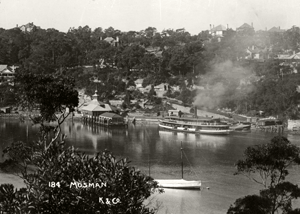Mosman Council traces the past

It is a quintessentially Sydney vista as the Mosman Ferry plies its way from Sydney Harbour one morning in 1915. This image and thousands of others are held in Mosman Council’s extensive local history digital archive, Trace, hosted on the Canto Cumulus Digital Asset Management (DAM) platform.
Trace provides the public with 24/7 access to the large image database as well as resources such as oral histories, Council Minutes, Newspapers, and Subdivision plans which would otherwise be unseen and unheard, unless a trip to the library was planned.
As Councils become increasingly involved in creating and managing collections of digital content, they are more and more concerned with how to provide for efficient storage and retrieval of that content.
Sydney’s Mosman council needed a single portal through which all its staff could find and access anything they needed any time the department needed it. Canto Cumulus was selected as its image management repository / digital asset management (DAM) system and supplied by distributor DataBasics.
Council operates in a Windows environment. The Dataworks document management system is utilised for storage of incoming documentation and correspondence.
The initial focus for the DAM was on rich assets and processes used in the Library’s local history collection, including documents, books, plans, maps, anything that is useful in the research of the suburb’s history.
For the local history collection hosted at http://www.mosman.nsw.gov.au/library/local-studies/ the Cumulus DAM is being used to host decades of physical photos, documents and microfiche and microfilm which are being digitally transferred, augmented by an explosion of digital assets.
“Cumulus for us isn’t just a means of storage, it’s a way for people to access Council’s local history archive via the Web,” said Local Studies Librarian Donna Braye.
One of the motivations to acquire an on-premise DAM was to migrate Library’s public image and document collections from a hosted online solution, Searchtech.
Initially there were issues with providing public access to image libraries on Cumulus while protecting Council’s internal network systems.
Council required the addition of new public IP addresses. To secure the Council network, the Cumulus service was split onto two separate servers, one isolated and only available to internal clients.
The other placed behind the DMZ and made accessible to the public. The DAM’s reach is now being extended across all of council’s operational divisions. Council staff are now learning to place all images from photographs they take or acquire as part of their work into the DAM rather than dump them into a desktop drive
“That is a learning experience for some people so it’s not happening as quickly as we would like, but it will happen,” said Braye.
“The problem with using a file server as a central file repository is that everyone has their own file naming conventions, and their own ideas about where things should be stored. Plus, there are no previews, so you have to download something before you can even see what it is.”
“It was very hard to find images relating to stormwater for instance if they were need for publicity or other purpose, because there was no one place to store them.”
All assets are stored on a central file server, and Cumulus keeps track of the access control, storage, metadata, searching, and retrieval, so staff can focus on their tasks.
The DAM acts as a repository and archive, enabling staff who require images for publicity, web and presentation reasons to have easy access.
Council is asking staff to tag images using its internal taxonomy to aid with classification and search.
When image libraries were imported from Searchtech to Cumulus there were some issues with importing the metadata. Council is now investigating the use of a tab delimited text file, or CSV, as a method of migrating metadata. At the moment, images are being manually transferred.
Staff also make use of social media sharing sites such as Flickr, although all images are also meant to be manually imported to the DAM as well. Presently council records on microfiche and microfilm need to be printed and then scanned in order to be imported to the DAM.
A Kodak scanner and software is used to convert to TIFF or JPEG. Images are then cropped/enhanced if necessary. They are then combined into a single PDF and OCRd using Adobe Acrobat.
